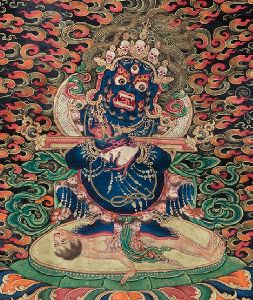
Mahakala Introduction
 Mahakala Resource Page | Mahakala Main Page | Shri Devi Resource Page
Mahakala Resource Page | Mahakala Main Page | Shri Devi Resource Page
Panjarnata Mahakala
Chaturbhuja Mahakala
Legden Mahakala
Chaturmukha and Brahmarupa Mahakala:
Short History: When the great Tibetan Translator Nyen Lotsawa received the Manjuvajra Guhyasamaja (also known as the Jnanapada Lineage) empowerment from the dakini Risula, she also bestowed the initiation of the Mahakala (Chaturmukha) in the special form according to the Guhyasamaja Tantra. At this time she gave him as a servant a dark skinned Brahman. When Nyen Lotsawa and the Brahman reached Nepal the servant changed appearance and took on the form of a monk, an appearance more conducive for travelling in Tibet. After the passing of Nyen Lotsawa the monk remained with Lama Nam Ka'upa and then later with Sachen Kunga Nyingpo.
Brahmarupa Mahakala is none other than Chaturmukha Mahakala of the Guhyasamaja Tantra. In his wrathful appearance he is black in colour with four faces and four hands, surrounded by the four dakinis. In the Sakya School it is inappropriate to show the wrathful form to anyone who has not received the initiation. For this reason the iconographic tradition arose for painting Chaturmukha in the form of the Brahman servant of Nyen Lotsawa. At the bottom of many Sakya paintings it is a common theme to see Panjarnata Mahakala flanked by the Brahman on the right and Shri Devi (Palden Lhamo) on the left - the three main protectors of the Sakya School.
Indian Lineage: Vajradhara, Nagarjuna, Balimtapa, Buddhajnana, Marmedze Zangpo, Shrideva, Drime Bepa, Ratnavajra, Ratnakirti, Risula Dakini, Nyen Lotsawa, Lama Nam Ka'upa, Sachen Kunga Nyingpo, etc.
Shadbhuja Mahakala (Six Armed, One Face):
The most popular form of Shadbhuja Mahakala was brought to Tibet by Khyungpo Naljor the founder of the Shangpa Kagyu School this form of Mahakala became popular in the Sakya and Kagyu traditions and was later adopted into the Gelugpa School, becoming the principal protector.
Shadbhuja Mahakala arises from the Eight-Chapter Mahakala Tantra belonging to the Kriya classification. The interlocutor or sponsor of the tantra was the deity Hayagriva. There are numerous other forms of Shadbhuja, the most popular being the wealth deity White Mahakala practiced in all traditions of Tibetan Buddhism. Variations in appearance are found in the different traditions principally the leg postures of Mahakala, the Gelugpa preferring the more wrathful posture with the legs apart. The Tsarpa lineage of Sakya prefers Shri Devi with four hands so as not to confuse her with Magzor Gyalmo the younger sister or servant that has two hands. The colours and hand objects of the remaining retinue also vary according to individual traditions. A further 75 deities (see below), in Tibetan called 'gonpo' (mgon po. English: lords) make up the outer retinue. This enumeration hinging on the word 'gonpo' the common name used in reference to Mahakala, has led to the mistaken Western notion that there are 75 forms of Mahakala in Tibetan Buddhism. Iconographically there may be fewer forms but textually there can be an infinite number.
The Seventy-five Lords of Pure Lineage:
The Ten Guardians of the Directions, (Tibetan - chog yong chu)
The Eight Great Gods, (Tib. - lha chenpo gye)
The Eight Great Nagas, (Tib. - lhu chenpo gye)
The Eight Great Planets, (Tib. - za chenpo gye)
The Four Worldly Guardians, (Tib. - jig ten kyong wa shi)
The Twenty-eight Constellations, (Tib. - gyu kar nyi shu tsa gye)
The Nine Great Bhairavas, (Tib. - jig je chenpo gu)
Lineage: Vajradhara, Jnana Dakini, Shri Shavaripa, Lord Maitripa, Mahasiddha Rahulagupta, Khedrup Khyungpo Naljor (founder of the Shangpa Kagyu School, 11th century), Nyamme Rinchen Tsondru, Bonton Kyergangpa (famous terton of the Hayagriva 'Secret Accomplishment' cycle of practice), etc.
Maning Mahakala:
Eunuch Lord (Tibetan: pal ye she gyi gon po ma ning nag po. English: The Glorious Lord of Pristine Awareness, Black Eunuch): the body emanation of Mahakala and lord of all enlightened and worldly protectors of the Nyingma School.
"...Glorious Lord of Pristine Awareness, Black Eunuch, with a body blue-black in colour, one face and two hands. Holding aloft in the right, pointed to the sky, a flaming lance, and in the left a poisoned heart and lasso. With three round red eyes, a curled tongue and hanging black snakes for hair. Having a crown of five dry skulls and a necklace of fifty fresh. Adorned with a garland of hearts and piles of snakes, dressed in silk cloaks, black and layered. Having a gold belt and a girdle of fresh human skin. From the three doors of a great stick of sandalwood, fastened at the waist, an army of snakes is dispersed. Decorated with varieties of colourful flowing streamers and all the frightful ornaments. Standing with the left leg extended atop a corpse seat..." (Terdag Lingpa Gyurme Dorje 1646-1714 and Minling Lochen Dharmashri 1654-1718. Tibetan source text 'dod 'jo bum bzang, Part II, page 121-123).
"Glorious great emanation of the body of the Great Black One, trustee of the king of the wrathful, executioner of enemies and hindrances, great deity, glorious and blazing, lord of all Dharma protectors; homage to the glorious lord, Black Eunuch." (Nyingma liturgical verse).
Lineage: Kuntu Zangpo, Chemchog, Palgon, Orgyan Yab-yum, Terton Chowang, Manlungpa, Dagton, Nyenton, Sedingpa Khupon, Paljor Wangchug, Chokyi Wangpo, Karma Guru, Nyadag Trulku, Chowang Kunzang, Rigdzin Tinle Lhundrup, etc. Also see the variant lineages of Dorje Lingpa, Ratna Lingpa, Pema Lingpa and Jatson Nyingpo.
Copyright © 2025
Himalayan Art Resources Inc.